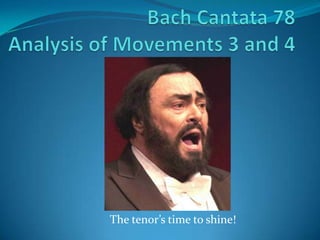
Bach cantata 78 movements 3 and 4
- 1. Bach Cantata 78Analysis of Movements 3 and 4 The tenor’s time to shine!
- 2. Recitative Recitative is a declamatory or speech-like form of singing used often in opera, oratorio or cantata It is usually syllabic (one note per syllable) The words are extremely important – they dictate the rhythm of the melody (a bit like rap!) A recitative is always sung by a solo singer Melodies tend not to be as lyrical as in arias and are instead dissonant and jagged
- 3. Text of Movement 3 “My failings sorely grieve me! My sins are very great, The curse of Adam never more will leave me…” The mood of this movement is shockingly dark when compared with that of movement 2 The text refers to “children of sin”. Bach uses dissonant harmony and wide intervals to emphasise the anguish of the words As the text becomes more repentant, with the singer praying that he be forgiven, the setting becomes more gentle and pleading in nature
- 4. Movement 3 – Recitative Secco This movement is an example of a Recitative Secco, which means that the recitative is quite bare with a very sparse accompaniment Tenor and continuo play in this movement Movement is in common time but there is not a strong sense of pulse Tonality is quite uncertain. At different points it appears to be in c minor and f minor
- 5. Movement 3 – Recitative Secco (contd.) The melody line is full of large leaps and dissonantaugmented intervals The harmony includes many diminished and augmented chords The vocal part ends its phrases unaccompanied The style changes towards the end of the movement. A new tempo is imposed by a repeated pedal note in the continuo. The vocal line become more lyrical with the introduction of melisma on the word erzurnet(angry)
- 6. Movement 4 - Aria Text: “Thy sacrifice has cleansed the stain, making my heart all pure again, happy and free.” Light-hearted and lyrical contrast to the previous movement Aria duet between flute and tenor with continuo accompaniment 6/8 time (compound duple) Begins and ends in G minor, with a modulation to B flat major in the B section Form: Binary (A B1 B2) and ritornello form
- 7. Ritornello The opening 12 bar ritornello introduces the flute descant or obbligato The flute line is very florid, containing appogiatura and semiquaver sequences, which continue throughout the movement Meanwhile the continuo moves mainly in pizzicato quavers
- 8. Section A Mainly in G minor Opens with ritornello Tenor enters with the opening flute part, 12 bars later 4 bar ritornello Flute and tenor have a polyphonic 8 bar duet 4 bar ritornello, ending with a perfect cadence in B flat major
- 9. Section B Moves from B flat major to C minor to E flat major Semiquaver sequences in both the flute and continuo part Large leaps, notably on the words “Streite” (fight) and “beherzt” (brave), dominate the tenor part
- 10. Section B2 Opens with 2 bar ritornellotheme in E flat major Very similar to the B1 section This time there are more extended melismason the word “Streite” (“fight”). This word painting captures the ongoing battle with evil A dominant pedal note is sustained on the word “stehet” (stand) Dal Segno means that, after section B2, the music returns to the symbol in bar one and concludes with the opening 12 bar ritornello